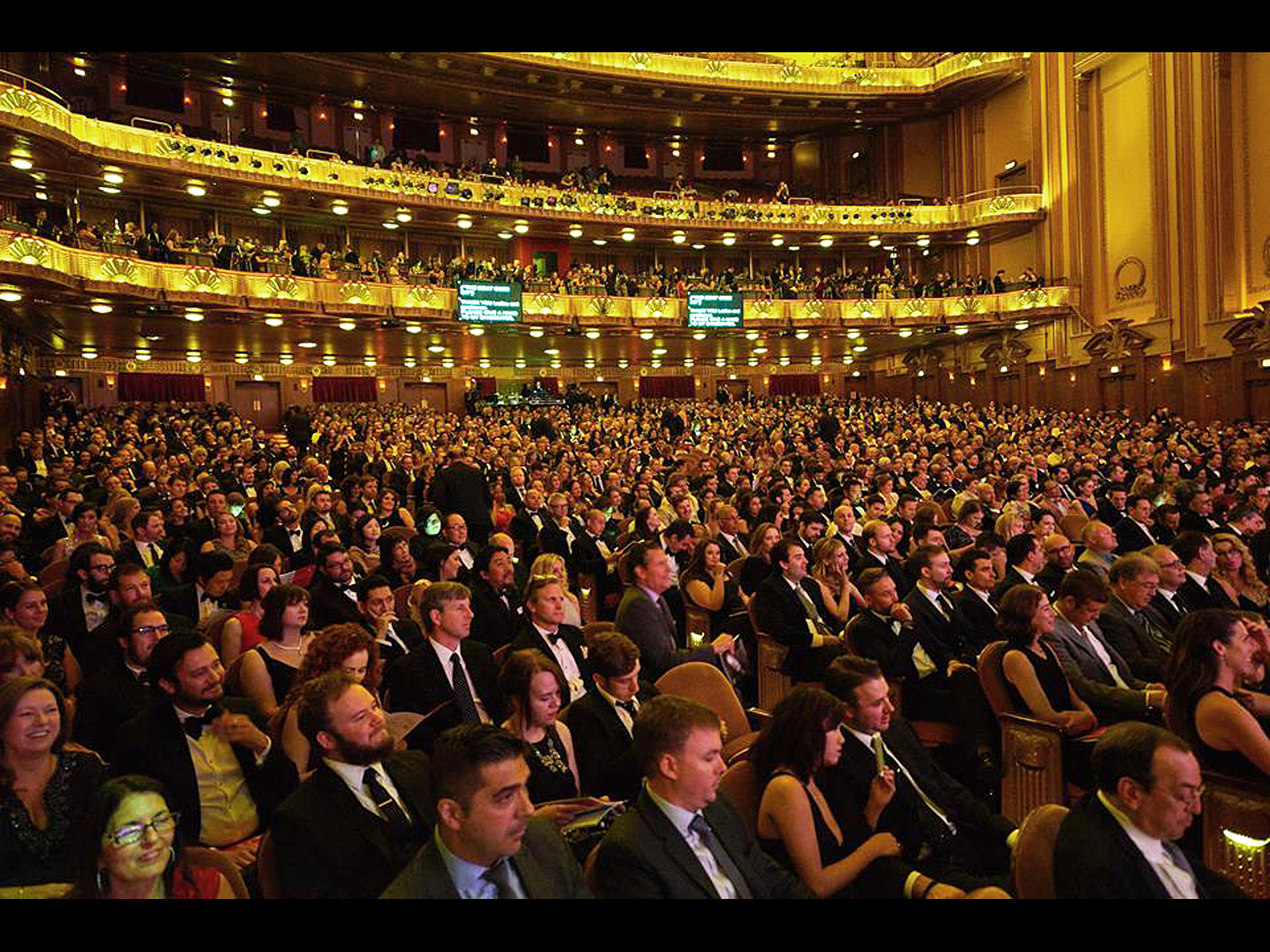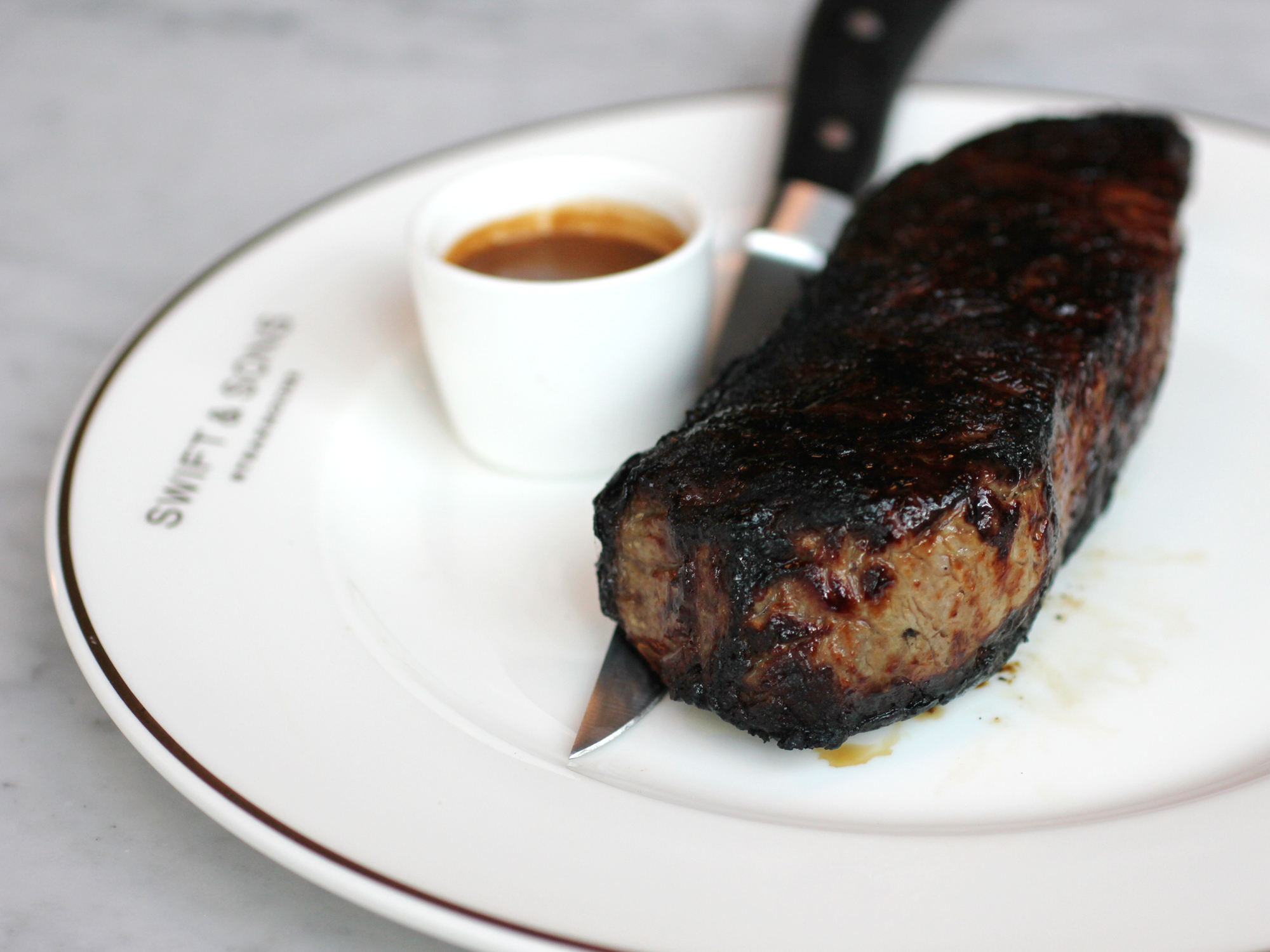WHEN A RESTAURANT REPRESENTS A CHEF’S point of view, his or her ethos and idea of what tastes good, how does someone else step into that kitchen and make it theirs without changing everything? That’s always a balancing act, but especially so for a restaurant as distinctive and influential as The Bristol. When it opened in 2008 with Chris Pandel as chef, the first restaurant of B. Hospitality owners Pandel, John Ross and Phil Walters, it didn’t just have a clear identity of its own—pork, offal meats, farmer names on the menu, rusticity, housemade pastas, long communal tables, a notion that beer or cocktails were just as good with food as wine. It caught the zeitgeist, the perfect moment for porky deliciousness and odd bits in an informal setting, and spread its love for them all over the city.
Of course, subsequent porky-casual places like Longman & Eagle and The Purple Pig wouldn’t have existed in quite the same form without The Bristol—and neither would restaurants in a wide variety of genres, from Fat Rice and Yusho to Bohemian House. It spread the Chicago gospel that deep flavor could happen in any cuisine in a hip relaxed setting, without the white tablecloths and thick wine book—and the fact that Michelin has never awarded The Bristol so much as one star is the most damning proof that they simply don’t get what matters to us now in dining out.
But Pandel has moved on to opening first Balena, then Formento’s and Swift & Sons. The Bristol is now under executive chef Sean Pharr, whom I first met at NoMI over their once-notorious $75 chicken, and I sat down with him to ask the question: how do you reinvent The Bristol, keep it the same but also make it new—especially when you’re in a world of places influenced by The Bristol? I dined there a couple of weeks ago (as a guest of the house, disclosure) to get an idea of the answer, and then Pharr and I started our conversation by running through his career before this point—which, I have to say, did not sound like a background that was meant to lead to an informal, communal tables place in Bucktown:
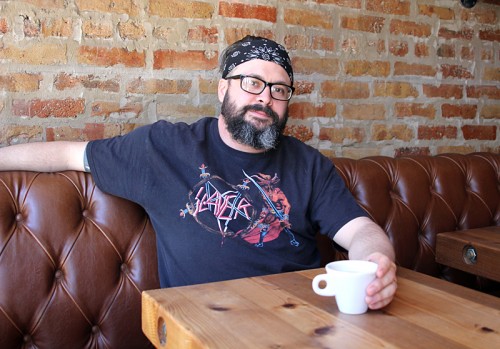
SEAN PHARR: My background is predominantly French and American cuisine. I started in Madison, Wisconsin, at a restaurant called Harvest, and I worked there for three years. And a few other restaurants as well, mostly part time, working as many hours as I could to learn as much as possible. Three jobs, at all times, for three years, and I about cleared $19,000 a year. And I feel like I had more money then than I do now as a parent, for sure.
But it was great, I grew up with farmers literally coming to the back door, and the [Dane County] farmers market across the street from every restaurant that I worked at in the Capitol Loop, and just thinking that that was the way restaurants worked.
FOODITOR: Because everyone has a farmers market that takes four hours to shop across the street.
Let alone that the farmers bring it up to your door the other four days a week, because they want to hang out. So it was a really cool thing to see the chef’s relationship with farmers, how that works and how it works with great product.
And then I moved to Chicago to work at Tru, which culinarily was such an amazing adventure for me. I went to work with two Alain Ducasse alums, Joel Dennis and Laurent Gras. I spent a year with both of them, and my world was flipped upside down. It wasn’t the farmer, locally grown aspect, that sort of thing, but it was super-refinement on your technique. How hard can you push yourself in a day. 13 guys in a kitchen trying to outdo one another, in a family environment. We used to have the saying, “We did the work for free, we got paid to be afraid.”
Joel Dennis was the chef de cuisine under Rick Tramonto, but he was doing his Wheeling project by then, so they brought in Laurent as a consultant. And he started kind of doing his prelim for L2O though us. We were kind of the petri dish for L2O. So one week we’d be studying a classic Ducasse jus, or how to poach a fish with Joel, and the next it would be Laurent teaching us how to do an avocado emulsion on methylcellulose-set avocado dumplings in the greatest piperade sauce I’ve ever had, but then it was covered in the champagne supernova of foam over the top of it.
The Bristol is this amazing workshop where you can really get away with whatever you want to do. You can put any type of cuisine on the menu as long as it has an ability to relate to a customer.
From there I thought I wanted to get out of fine dining. So I opened up a bar and grill in Uptown, Fat Cat—which was awesome. It was a lot of fun. But it made me realize my heart lies in fine dining… tendencies. Whether it be something that’s more approachable for people, or something that’s very technically driven for the back, but still translates well to the guest. That’s kind of where I’ve found myself being driven—I spent the last three and a half years at NoMI as the chef de cuisine. They brought me on when they took away the tablecloths, and wanted more approachable food, and less of a “No” atmosphere, more of a “Yes we can try and do that for you.”
That was hands down the greatest experience I’ve had in a restaurant. The quality of staff, and systems, and management, and budget—having piles of circulators and induction burners under your desk because you don’t need them yet, but you had to spend the money—
I was just looking at an interview I did with Andrew Zimmerman the first year he was nominated for a Beard award, and that’s what he mentioned about NoMI—so much expensive equipment.
It was fun like that. It was interesting, too, because I got tasked with the job of actually making money in that restaurant. Which was tough, because there’s union dues to pay and all kinds of things that customers don’t realize come into it. We talked about it a few years ago, with the $100 chicken you wrote about—
It was only $75 when I had it. And it was for two, it wasn’t that crazy.
It was a $37.50 entree, which is cheap!
I did tell the farmer, T.J., about it at Green City once. He was like, damn, I gotta find out how you make a $16 chicken worth $75.
My buddy Justin Carlisle [of Ardent in Milwaukee] was telling his dad [who raises cattle] what they sell $4 a pound Carlisle beef for at The Publican, and his dad said, well, that’s going up a buck a pound now.
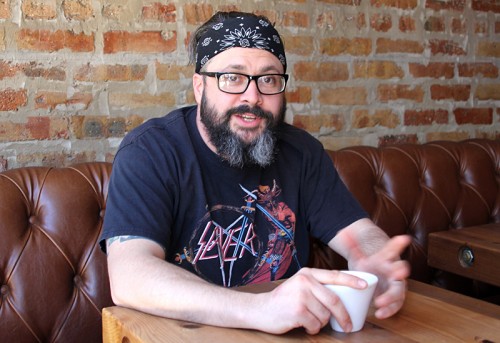
Anyway, NoMI was a great experience and that was with a French background, that sort of technique. In between all of that I’ve worked for Italian restaurants, like Osteria via Stato. And I’ve always had this leaning toward, really simple, and a small amount of ingredients, but preparing them the best that they possibly can. And that’s why when you look at my food now, even though, the shrimp cakes for instance are a classic French shrimp mousseline, at the end of the day it’s local white grits, my grandmother’s chow-chow recipe from 1921, just very simple and small, but a lot of technique goes into it and a lot of concentration on how everything tastes on the plate.
Okay, so I have to say that that doesn’t sound very much like the career path for taking over The Bristol. What did you call it, fine dining tendencies? I don’t think most people think of The Bristol as fine dining-ish, even if there’s some of that technique at work here—
And I don’t want them to think of it that way. That’s the balance of how I look at food. I look at what I want to accomplish, and what I want to teach [the staff], and values that I want to instill. And how does that get on the plate, and how is it recognizable for the customer so that they dont’t feel that they’re being alienated by the food. Which can’t happen here—this is a neighborhood restaurant, it had a seven-year history before I got here of being the place where you go to get a roasted chicken and the raviolo. The people that love those things are the neighborhood people. I learned very quickly to embrace them, and understand that I need to honor them and keep things going for them.
At the same time The Bristol is this amazing workshop where you can really get away with whatever you want to do. You can put any type of cuisine on the menu as long as it has an ability to relate to a customer, or doesn’t alienate someone. So the furthest reach on the menu I have right now is the fried rice. Which at the end of the day, every person in Chicago has had fried rice. And I selfishly love fried rice, it’s like my day off food. But I wanted to see what I could do with weird off-cuts of meat [beef belly in this case], which this restaurant is well known for, and it’s now one of the highest-selling items.
I get to do whole-hog butchery here, which I didn’t ever do at any restaurant, because I now have a way to sell the head, I have a way to sell the trotters here, whether I’m doing porchetta or now I do the pork chop program, the skin-on belly pot-au-feu—there’s just a million outlets for all these things, and I’m allowed to change on a dime.
I’ve never been one to chase what’s hot, I stay within my comfort zones. Trying to focus on making sure everything on the plate is delicious—there’s no extraneous garniture.
Which is why this restaurant is so beautiful, because for somebody who has a short attention span, for somebody who grows tired of his food so easily—the joke at NoMI was that the second it went on the menu, I hated it—The Bristol has a healthy balance of that. I can rip through 98% of this menu and change it as fast as I want, but at the same time I keep the half roasted chicken on, I keep the raviolo on, because I want these people to feel like they can come in, get what they know is great, get a great dinner and still reach out and try some new things.
So you’re talking about experimenting, but what’s still on the menu from before?
Well, the half chicken, the raviolo—oh, and I brought back the apple salad with manchego and hazelnuts. That’s a classic that’s been on the menu since day one.
I walked in on the day they opened up—I had a very loose relationship with Chris, he had worked for Tramonto and he and I knew each other through a mutual friend from Tru. I’d always heard about Chris—I’ve chased his career inadvertently over the years, working where he had worked before. I walked in and they were still trying to hang shelves and it was a complete shitshow, and I just said, good luck man.
In no time this place was hot, and anybody in the industry, any time I had folks in from Madison, we came here. I remember my first meal was a burger, it was Scotch olives, it was the chorizo-stuffed wings, and it was all awesome. It was just a cool vibe here. Now, like you said, it’s been pretty replicated. I tell the owners, this is a genre of restaurant, whether you created it or it was created at Chez Panisse, twenty years earlier. But it’s a genre now and it’s important to try to stay relevant.
So no more monkey bread?
I hated the monkey bread when I ate it.
Well, it made it easy to come here when my kids were littler, that’s what I liked about it.
It was fun because it was tactile, sure. My argument against it was, one, I didn’t enjoy it as a customer. But two, after being here two weeks and watching the exec sous have to break off from what prep he was doing because everybody else was so in the shits, and have to roll like 40 cocottes of monkey bread, little ball portions and there’s like twelve per thing—it was a two-hour project, let alone the pastry chef having to get the dough set in the morning, my immediate response was, Parker House rolls. Because they’re easier, they’re delicious—now we’re down to four balls each, but they were still a pain in the ass.
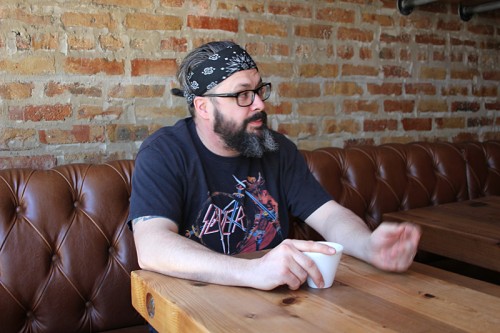
There was a lot of blowback from that, and I still get somebody once a week saying, I want the monkey bread. I understand that. When they took the foie gras and creme brulée off the menu at NoMI people were pissed, but we stuck to our guns. Like, you don’t need to eat this. This isn’t who we are.
I’ve even changed the bread program since then. I ate at Battersby in New York and they had this focaccia that was so awesome and I thought, I could do something like that. So now there’s no rolling and there’s less proof time and it’s really rustic and we make ricotta in house for it and it’s awesome, it’s great. Miles Davis said, it’s about moving forward, not staying in place.
Charlie Trotter just smiled from heaven that you mentioned Miles Davis in an interview. So getting back to updating the menu, is fried rice the answer? I mean, why not—everything is more Asian-influenced now.
Well, partially—I mean, I said this when you came in to eat a couple of weeks ago, fried rice, when I went to eat in New York recently, Gramercy Tavern and Estela had fried rice on the menu. So I was like, yeah!
Chicago’s very trend-heavy. If I fall into trends, it’s sort of more on accident than intentionally—I’ve never been one to chase what’s hot, I stay within my comfort zones of knowing how to combine certain flavors. Trying to focus on making sure everything on the plate is delicious—there’s no extraneous garniture. I feel like the next level of The Bristol, where I’ve been trying to take it for the last year, is refinement and attention to detail. Certainly attention to technique in terms of what’s going on in the back. I’m constantly harping on these cooks in the back about consistency. Because at the end of the day, if you come back, you kind of want to have the same experience.
And that’s why I’m so hesitant when guests come in and say, I had this pork chop three years ago, can you do this? Much as I want to say yeah, I can do this, one, I don’t know what it was, two, you’re probably not going to remember it being what it was, and it’s not who I am. Andrew Zimmerman said this when he took over Sepia—if you like something, have it now, because it’s going to be gone soon. I’m not here to hold on to the past, I’m here to be grateful for the customers who have supported us in the past, but in the end, it’s about moving forward and not becoming this tiny dark dining room that slowly gets less and less occupied.
Gallery: Sean Pharr’s Dishes at The Bristol
Photos by Kailley Lindman
So tell me about some of the dishes that you think really typify your 2016 version of The Bristol.
I would say that our charcuterie stands out in Chicago—I don’t want to sound like a braggart, and I don’t do curing and salume, because I can’t afford to hang stuff for a long time. But the old school stuff here, the pâtés, the terrines, the mousses, the headcheese, all the offal stuff and the cooked charcuterie on that end—we have a way of making it delicious for anybody who would say, I might not even like that. Then they try it and it’s like Holy crap, this is super-good. Like most people wouldn’t dare eat lamb liver pâté, but I pride myself on making these things approaching and delicious and not masking the flavor by, like, putting it inside of a cheeseburger.
We don’t have to have a set menu that’s programmed and tested. We don’t have to constantly play it safe. We have customers that come twice a week to make sure that I’ve got some kind of kidney or liver on the menu.
The fact that I’m making the menu less pork-centric—even though the pig is still a huge deal for us here, but aside from the charcuterie, it’s not a lot of pork entrees—there’s usually like one on the menu. But I try to have five seafood things, five vegetarians, three to four pastas—our pasta program’s super-strong here. It’s just about—I just want simple, delicious ingredients.
I was going to ask about pasta, because Chris once said to me that it was really an Italian restaurant—
At one point, The Bristol was the best Italian restaurant in town, until they opened Balena. You don’t really realize it until you’ve maybe been to Italy, or studied Italian cuisine, but the philosophy was 100% Italian. To be honest, the owners didn’t even know—John and Phil said to me, they didn’t realize it was an Italian restaurant—
“Chris, we have to talk!”
Yeah, this is supposed to be an American bar and grill—
But what’s more American than Italian food?
Yeah, right? I think that’s where it was a great transition between Chris and I. Aside from being similar our outside lives, we’re very similar in food thought. The idea of not wasting food is big for me, even though I came from a restaurant where I could literally throw half a lobe of foie away, or render it to cook porcini mushrooms in. I had to get rid of that idea real quick, but utilizing everything, that’s a very Italian concept. So it was an easy transition for me, and it’s fun, because it’s a challenge.

That’s where The Bristol stands out, because we don’t have to have a set menu that’s programmed and tested, and have to have the buffalo nachos, and this and this. We don’t have to constantly play it safe, we can just keep going and going and going and people are always receptive to it. We have customers that come twice a week to make sure that I’ve got some kind of kidney or liver on the menu.
What about dessert? Who is the pastry chef now? I don’t even know.
I have a lady named Celeste Zeccola who’s running the pastry program right now. She is one of the coolest people I’ve ever met. She does this and she teaches at a culinary school, so it’s not like her full time gig, but she maintains the program for me and we talk a lot about where we want it to go. Eventually we’re going to have to have a conversation about whether she wants to come on board fully and own this program.
The basque cake will always have to stay on, it’s a heart-stopper but it’s delicious, I brought one to my trainer and he just housed it. And I’m like, you have no idea how much butter you just ate, bro.
But Celeste’s background is great—she worked at Gordon’s with Charlie Trotter’s, when she was on garde-manger and he was a cook. And she would talk about how much of a mess he was when he was a cook. And New Year’s Eve Chef Roland [Liccioni] came in through the back door and gave her a bottle of wine, because she worked for him forever. She has a past that we’re really delving to try to break into—she knows how to break down chickens, she’s super-classic, super-low-key, I just don’t want to push her where she doesn’t want to be, because we all know what it’s like to be unhappy in a job.
Well, that raises an interesting point in terms of having someone who goes back to the 70s and 80s in terms of their experiences. And we’re talking about you maintaining a legacy that goes back all of eight years. Do you find yourself talking heritage to a crew who were, like, 14 when The Bristol opened, and have only been eating well for about two years?
I hold nothing sacred, in that right—
But do they even know what you’re talking about?
I don’t think so, I don’t think so at all. I referenced Back to the Future the other day and some of my employees were like, Huh?
There’s a lot of things in the past that nobody knows about now, because of Food Network and how in our face the industry is being crammed, now. I mean, I’ve only been doing this for twelve years now, I started becoming interested in cooking when it was Sara Moulton and Emeril Lagasse on TV. And I won’t lie, back then I thought that was awesome. But it wasn’t at all what it is now, this focus on everybody’s a chef, and cooking is so cool—this industry is not cool. This was a terrible choice (laughs).
But I love it at the same time. But I feel like a lot of it’s getting lost. A lot of the backstory—I just put together a new recipe binder for all the new recipes we’re putting on, and I put on the cover a quote from L’Escoffier, talking about how we’re lucky to have all these ingredients and it’s our job not to screw them up. And nobody knew who that is.
It’s scary to me, and it’s part of the reason when I was talking about technique, I try to incorporate all these things, I try to bring back things they ought to know. Like if you ask a cook now to make a béchamel, they ask what kind of cheese to put in it. That to me is terrifying. That’s why béchamel is on the steak’s side now, with creamed spinach, because I need people to maintain the knowledge of this.
All right, anything you want to say by way of summing up your feelings about the sheer terror of taking on a locally famous restaurant?
I didn’t feel any pressure about taking this over. Which is weird. I was originally slated to be the chef at what’s now Swift & Sons; I joined the company two years ago, and I helped them at Balena for a little bit while Swift & Sons was getting built, and just kept getting pushed back and back. And I helped them open Formento’s with Tony. And after seeing them open a restaurant that big, and seeing twenty pounds of garlic in dry storage and coming back half an hour later, and it’s gone and you have no idea where it is, and there’s 35 cooks in the kitchen and you’re like, who processed all the garlic—that scared me. And I didn’t want to be part of that.
This is so similar to Harvest, where I started learning how to cook—three to five guys on the line, maybe, on the busiest nights; small lines, small coolers, and a tight group. I started prepping out of this kitchen for a lot of our events and started falling in love with this place, the idea of being able to run something like this. And falling in love with it as a dad, when I bring my children in here. My daughter Abby, when she was like one and a half, the servers were so great, and they were so accommodating to make sure that she was comfortable, and they didn’t care that she was throwing shit everywhere—I just stafted getting this sense that… this is home.
And then, out of really cool, quirky circumstances, they were like, would you take The Bristol over? I was like, YES! Yes! Because otherwise, I’m going to take a job at Dick’s Sporting Goods, in the hunting section.
I wasn’t scared about taking this over, it was nothing but pure excitement. The scary parts for me are the things that a small restaurant chef has to deal with, compared to what I came from at NoMI, where they had the systems. I’ve washed dishes so many times here now. Man, I would kill to have a union dish staff now, five guys that are in the tank making 20 bucks an hour with full benefits, but they showed up every day and things got taken care of. When small things happen in a restaurant like this and it’s packed, those are the things I’m terrified of. But the food, the customers, the restaurant itself, the service—that’s the joy of this restaurant. It’s cool.
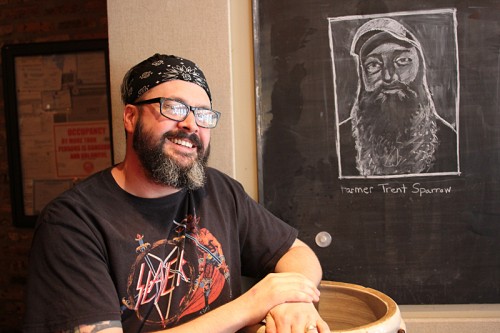
The Bristol always had a chalkboard of its farmers; Pharr says, “But they weren’t my farmers, I didn’t know them,” so he replaced it with a board dedicated to his favorite farmer, Trent Sparrow of Catalpa Grove Farms. The menu chalkboard he felt was an outdated idea, so he replaced it with a giant finger inspired by Monty Python. “It means this way is the kitchen. Or the bathroom, or the bar. Whatever you want it to mean.”
Michael Gebert is the editor of Fooditor, and once ordered duck fries at The Bristol. Not duck fat fries, this.
Latest
Join the Discussion
After you comment, click Post. If you're not already logged in you will be asked to log in or register with Disqus.










